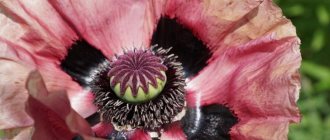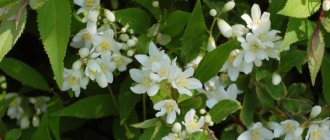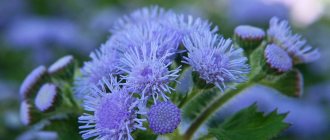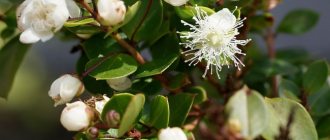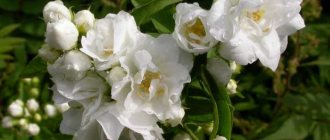Botanical description of ginura
In the genus you can find subshrubs and perennial herbs. Shoots grow vertically at a young age, but over time they take on a horizontal position. At home, it can be grown as an ampel plant in hanging pots.
Thanks to its exotic coloring, it received the names: “woman with a tail” and “blue bird”.
"Woman with a Tail"
Drooping stems can be up to 1 m long. Thanks to the lateral shoots that form on the branches, the bush looks thick and attractive.
The oval oblong leaves are attached to the stem with short petioles. The location is another thing. The leaf blades are larger at the bottom and smaller at the top.
On the underside of the dark green leaves there is pubescence, brightly colored violet, lilac or purple. The leaf margins and central vein also have cilia.
Blue bird - interior decoration
At the beginning of December, ginura is covered with a scattering of flowers, the petals of which are colored orange, purple, green, and red. Flowering continues until the month of May.
If favorable conditions are created, ginura flowering can continue all year round.
The flowers are arranged in corymbose inflorescences and have the shape of a ball. During flowering, the bush emits a charming aroma. But not all gardeners like this smell. Therefore, as soon as buds appear on the bush, plant owners tear them off and enjoy the beauty of exotic foliage.
Bluebird in bloom
In place of the flowers, seed boxes appear. Fluffy tails are clearly visible at the end of each of them. The herbaceous plant is easily propagated by seeds.
Let's get to know the strange ginura
It is no coincidence that Ginura is called one of the most fashionable and interesting decorative foliage indoor crops. This plant is truly impressive and offers year-round attractive “textile” accents, a subtle play of undertones and bold leaf lines. Velvety, luxurious, unusual ginura is the perfect small accent, a plant with a twist.
Gynura are herbaceous shrubs and perennials with long, whip-like shoots and winter-green foliage. Ginura branches are tetrahedral and reach 1 m in length. But at the same time, the height of the ginura does not exceed 30 cm and grows in breadth. The lower leaves are always large, up to 20 cm in length, and the upper ones are much smaller, clasping the shoots. Leaves with a beautiful serrated edge are most often obovate, but their shape may vary among different species and varieties. The foliage gives the entire plant a graphic and elegant appearance. The ginura leaves, velvety to the touch, amazingly combine the softness of the edge and “spiky” lines. Carved, with teeth, peaks and “thorns”, they give the entire plant an impregnable, somewhat stern appearance. True, it is softened by the play of colors, which should be given special attention. The reverse side of the leaves is purple, the color seems to shimmer over the edge and extend to the upper side of the leaf blade.
Two types of ginura are grown in indoor culture:
- colorful perennial orange ginura (gynura aurantiaca), forming a lush mass of bright leaves, suitable for both potted and hanging culture;
- More suitable for hanging culture is the rare climbing ginura (gynura scandens), which looks great in pots thanks to its shorter branches and forms original and dense bushes. Its leaves are smaller, softer, and ovoid.
This is an amazingly colorful plant, whose popular nickname “blue bird” seems to argue with the specific name - orange ginura. Actually, you won’t find any orange, yellow, or any other warm colors in the hydra. But at the same time, the plant, better known for its unpretentiousness, never ceases to amaze with its variety of color palette. Basic green and purple combine on the plant in amazingly beautiful and soft transitions. The play of two shades and their saturation are influenced by growing conditions. And if in classic ginurs the purple edges of the leaves and bright fuchsia petioles seem to gradually blur to dark green with a bluish tint, then in many ginurs the color changes in room conditions, becoming darker, less or more saturated. Watching the plant is a pleasure. After all, the leaves, after blooming, are brighter, gradually acquire “separateness” and become more and more green.
But the flowering of ginura, although not the most striking, is very attractive. The touching forms and tenderness of the flowers, surprisingly vibrant against the background of the leaves, seem enchanting. Basket-like inflorescences with a bright golden color bloom at the tops of the branches. But the unpleasant smell slightly “scares away” the ginura inflorescences, and flowering can lead to disruption of the usual bushiness and beauty of the crown. Therefore, many gardeners pluck flowers, preventing them from blooming. Flowering of ginura begins on the eve of autumn.
All ginurs are poisonous plants. When working with them you need to be careful and don’t forget to protect your hands. Ginura should not be used in the interior of children's rooms.
Orange ginura (Gynura aurantiaca). ©John Lodder
Types and varieties of ginura: photo gallery
Ginura
There are 50 species of gynura in their natural habitat. Not many have taken root at home.
Ginura variegata
The beauty of the soft pink leaves of Ginura variegata attracts the eye
Ginura variegata The bush has unusual foliage, which is light pink when young, and with age, dark green spots appear on the leaf blades. Also, with age, the delicate light pink color remains only along the edges of the lower leaves located at the base.
Ginura ascending or Ginura climbing (scandens)
Yellow flowers look spectacular against the background of purple-brown foliage
Ginura ascending or Ginura climbing (scandens) Very rarely found in nature and is represented by a subshrub. The toothed leaves of the petiolate leaves are arranged alternately on the stem. Along the leaf, on both sides of the central vein, there are beautiful stripes of bright green color. The purple-brown leaves have small teeth along the edges.
Orange ginura (aurantiaca)
The narrow petals of the orange ginura are painted golden.
Orange ginura (aurantiaca) The distribution area of the evergreen shrub is the island of Java. The bluish-green ovate foliage is covered with purple cilia. Along the edge of the leaf blades there are teeth, the length of which varies significantly. The inflorescences-baskets contain small golden flowers.
Ginura pinnatifaris
Original coloring of Ginura pinnateris
Ginura pinnatifarisa This species is considered medicinal and is listed in the Red Book. In its natural habitat it grows in the southern regions of China. The shoots are long and hanging. The oval leaves are bright green in color. During flowering, the plant produces a long peduncle, on which beautiful red-orange flowers in the shape of a ball bloom.
Ginura wattle (sarmentosa)
A common species in indoor floriculture
Ginura wattle (sarmentosa) Miniature bright green leaves of the wattle variety are densely covered with long lashes, pubescent with lilac cilia. The length of the shoots is maximum 60 cm. It blooms with yellow or orange flowers.
Trimming
Types of ginura that do not grow in an ampelous form need a garter, since its shoots do not hold their shape well and lie down. This not only spoils the appearance of the flower, but can also lead to a premature stop in its development. In addition to tying, the plant needs pruning, and this applies to all its forms. It is necessary to regularly pinch the tops of the shoots to stimulate the growth of lateral shoots and the formation of a thick and beautiful shape. If you let the shoot stretch out to its full height, it will begin to become bare at the base, and the picture will become unsightly. Pruning is done in the spring. This is the best time from the point of view of vegetation, and in addition, it is after a dark winter that the shoots noticeably stretch out.
Ginura: flower care at home
Ginura flower (bluebird)
If the conditions are met, the plant will willingly grow, branch and delight the grower with beautiful flowers, albeit with a specific smell.
Optimal lighting
Ginura flower
To preserve the decorative appearance of the foliage, you will have to choose a place where the plant would feel just fine. With a lack of light, the color of the leaves fades. It’s good if it is possible to place a flower pot near a south-facing window or on a western-facing window sill. In the hottest sunshine, the ginura will have to be shaded from the scorching rays of the sun.
In winter, the plant does not have enough natural light, so it will have to be illuminated with fluorescent lamps.
Selecting soil for planting
Exotic bluebird fire flower
For cultivation, you can take soil prepared at home.
Soil composition:
- turf soil - 2 parts
- humus - 2 parts
- sand – 1 part
- leaf soil - 2 parts
The flower will feel good in purchased soil. The main criteria when choosing soil are: good breathability, looseness and neutral reaction.
Before planting, add a layer of expanded clay to the bottom of the pot. This is a prerequisite for successful cultivation.
Temperature
Ginura at home
During the growing season, it is necessary to maintain a temperature of +18-23°C. You cannot place a pot with ginura in a place where drafts cannot be avoided. In winter, if there is no additional lighting, the bush is kept in a cool room with a temperature of +12-13°C. Thus, the plant is at rest and gaining strength.
Watering rules
In the summer, go to the garden!
The intensive growth of the plant requires abundant watering, which is carried out after the earthen clod has dried out. The roots should not be allowed to remain in soil that is too wet all the time. The plant needs moderate watering.
Insufficient watering leads to wilting and drying of the leaves. The lashes become sluggish and then it is very difficult to restore their turgor.
When kept in a cool room, during the dormant period, the plant must be watered as needed, avoiding prolonged drying out of the soil. And excessive watering will lead to rotting of the roots.
It is best to water with soft, settled water, which should not come into contact with the velvety foliage during watering.
Humidity
Ginura flowers
The plant is unpretentious to air humidity, but does not tolerate excessive dryness. In winter, due to the hot air emanating from heating devices, the ginura may need additional humidification.
You should know that decorative foliage cannot be sprayed. Spraying will have to be abandoned. To increase humidity, it is recommended to place the plant pot on a tray with pebbles and moisten them from time to time.
Pruning rules
Ginura
In early spring, when the plant's dormant period ends, it is recommended to shorten the long lashes. The procedure is performed to make the bush decorative. Forming a crown is a simple procedure that only involves pinching the shoots.
Fertilizer application
Ginura
Feeding is carried out throughout the growing season once every 2 weeks. Fertilizers cannot be applied during the dormant period.
How to carry out a transplant correctly?
The plant is grown in the most illuminated place
Transplantation is carried out as needed. It is advisable to postpone all work until spring. However, if the cultivation takes place under additional lighting, the plant can be replanted in the fall.
Annual rejuvenation of the plant is recommended, since the beauty of the velvety leaves loses its attractiveness with age. Or the plant needs a garter.
Care errors
Improper care of the purple ward can lead to a deterioration in the appearance of the ginura. What to do in this case?
- The shoots are pulled out and the leaves are crushed. Move the flowerpot to a more illuminated place or illuminate it with a phytolamp.
- The leaves have lost turgor. Water the plant correctly. Either there is not enough water for it, or the ginura receives moisture in excess.
- Leaves are falling. Increase the humidity around your green friend and water more often without using cold water.
- Slow growth. The bush signals the need for fertilizing.
- Dry spots appear. These are sunburns. Shade your ward in the afternoon.
- Weeping spots. While watering the plant, you wet the leaves. They may also appear at low indoor temperatures.
- Leaf fall. It starts due to poor watering.
- The leaves lose their purple color and turn pale. Move the flowerpot from the shade to the light.
Reproduction methods
The cuttings have taken root and can be transplanted into a substrate of shade
There is nothing complicated about reproduction. Cuttings are the simplest method of obtaining new specimens. Any apical cutting taken from the mother plant will certainly sprout roots.
You can first cut the long stem and then cut it into cuttings. They will all take root, despite the fact that most of them will not have a top. New sockets will appear in the sinuses.
You can root in water. After a week you can already admire the roots.
Planting and transplanting
Ginura needs periodic transplantation, but not so often that this process obeys some kind of algorithm. It is enough to focus on the needs of the plant. If the roots are tightly entwined in the earthen ball (irrigation water quickly seeps through them, flowing onto the tray of the pot), then it’s time to change the container. There is no need to disturb the flower in vain.
It’s clearly time to transplant such a ginura
The best time to transplant is early spring. The procedure is carried out on average once every two years. During this time, the flower often grows greatly, and the stem stretches unsightly. To prevent the decorative effect from suffering, instead of replanting, in this case you need to cut off the top and re-root.
When transplanting ginura, a layer of drainage material at least 3 cm thick must be placed at the bottom of the container. The substrate is prepared from the following ingredients: equal parts turf and leaf soil, humus and a little sand (approximately 25% of the total volume of the mixture). Ready-made soil can be purchased at a flower shop. This should be a universal mixture for decorative foliage indoor plants.
Soil for ginura can be purchased at a specialized store, but experienced gardeners prefer to mix the soil themselves
Growing problems: pests and diseases
Ginura
Insufficient care of the plant can lead to dire consequences. Ginura may become sick, or various insects may appear on its decorative foliage. Depending on the season, you can see different pests on the plant. If any are found, you will have to immediately carry out treatment to save the plant from death.
Shields
Shields
Scale insects are small insects with an oblong body covered with a chitinous shell. By sticking to the shoots, scale insects suck out the juice from the foliage. As a result of their vital activity, the leaves turn yellow and fall off. The plant stagnates and slowly dies.
To combat the pest, you can use Actellik. To get rid of the insect, double treatment is necessary.
Mealybugs
Mealybugs
Mealybugs Settling on a plant, they feed on its sap.
They got their name due to the fact that as a result of their life activity they leave a cotton-like discharge on the leaves and stems.
The plant begins to hurt, growth stops, the leaves turn yellow, and over time it may die.
Some types of parasites cause damage to the root system. For control they use the insecticides Fitoverm, Aktaru, Calypso.
Spider mite
Spider mite
Spider mite When examining the plant, you can notice small white dots on the underside of the leaves, and a thin cobweb may be woven around the lashes.
Unlike other parasites, spider mites are carriers of infections. If a plant gets sick with viral diseases, it will be easier to dispose of it than to cure it.
All means are good for pest control. In addition to chemical remedies, folk remedies help. You can fight with garlic infusion and avoid excessive dry air. As for industrial preparations, it is recommended to use Fitoverm, Actellik, Fufanon.
Whitefly – crown pest
Whitefly
Whitefly Most often appears on plants in summer. Small white-winged insects enter the house from the street through an open window. Whiteflies lay their eggs on the underside of leaves.
The fight is quite simple. You need to go to a specialized store and purchase one of the drugs: Mospilan, Actellik, Fitoverm.
Diseases and pests, ways to combat them
Ginura is resistant to various diseases, but if not properly cared for, it can slow down in growth or lose its decorative appearance. The most common pests of gynura:
- spider mite;
- whitefly;
- scale insect;
- aphid.
If they are detected, you should immediately treat the leaves with insecticides, reducing the recommended dose by 1.5-2 times. However, this must be done carefully and carefully - water only the soil, and spray only the underside of the leaves. The front side of the sheet is sensitive to moisture and will immediately lose its decorative effect.
Ginura will decorate the design of any apartment; it is beautiful, useful and undemanding to care for. Thus, this interesting plant can take its rightful place in any collection of indoor flowers.
Ginura in the house: signs and superstitions
Ginura in the house
In indoor floriculture, mainly poisonous species are grown. In their natural habitat, you can find some varieties that are considered medicinal.
Beneficial features
Cirrus ginura
Cirrus ginura is quite expensive and is considered a rare medicinal plant. In a province located in China, they are breeding this species for the purpose of selling medicinal raw materials.
The medicinal properties of procumbens are familiar to residents of Japan, America, Africa and China. They know firsthand about its healing properties. Eating leaves every day strengthens the immune system, a person does not know diseases.
Signs
Ginura in nature
Due to this peculiarity of flowering, that the flowers of the exotic plant emit unpleasant incense, it is popularly nicknamed “crocodile”.
If you place a flower in your home, you don’t have to worry about bad energy. The Scorpio plant copes well with this. A phrase like: “Sleep improves with a blue bird” actually has a good meaning. Indeed, it has been proven that keeping any type of ginura in the house improves the quality of sleep and prevents nightmares.
Parents whose children are afraid of the dark should definitely have a ginura in the house.
Many people with a harsh character become kinder, since soft velvety leaves are able to calm a formidable temper.
And most importantly, ginura is a flower that leads to female happiness.
Ginura care is quite simple. By following simple agricultural practices, you can get a well-branched bush of velvety beauty with soft and pubescent leaves. You can learn how to care for ginura at home from the video below.
VIDEO: Ginura – Flower Shop
GINURA | An unpretentious plant from the ASTER family | Care and breeding at home
Ginura - care at home: planting and pruning, growing conditions, methods of reproduction. Signs and medicinal properties | (70+ Photos and Videos)
Folk signs
Ginura orange is under the sign of Scorpio. Despite its toxicity, it is capable of energetically cleaning the home and helps fight phobias for those who are catastrophically afraid of the dark or suffer from nightmares.
A too tough person, having placed a flowerpot with a tropical guest on the windowsill, will become softer in character, even his voice will not be so rough.
And for people who are unsuccessfully struggling with their incredible amorousness, orange flowers with an unpleasant aroma will help them avoid further mistakes on the love front. So don’t rush to pick off the buds, but simply move the flowerpot to a more shaded place to get the desired effect.
The purple miracle will help unmarried girls and women find family happiness.
Possible problems
- Loss of bright hair color - the most common cause is lack of lighting.
- Leaves fall off - the specimen is too old or there is a lack of watering.
- Leaf blades become smaller - poor soil or lack of light.
- Too elongated, bald shoots - there is not enough light or the necessary spring molding of the crown has not been carried out.
- The appearance of brown spots on the leaves means that water got on them during watering or spraying was done; henceforth it is necessary to prevent moisture from getting on the leaves and shoots.
Healing properties of ginura
Ed Grows ginura in the suburbs of Limassol
Gynura is grown on the Via Vitae Estate in the suburbs of Limassol. Close attention is paid to the environmental cleanliness of the process.
Over the past year, the plant has become known to the island's residents. Gynura changes the quality of life. The uniqueness of its action lies in the fact that it helps restore impaired metabolism and metabolic processes of the body , bringing them back to normal. This is especially important in our age, when the impact of all kinds of negative factors is so great: the environment, stress, a sedentary lifestyle and poor nutrition. Ginura is capable of almost literally raising a person to his feet.
Costas Gregoriou became interested in the new product and has been observing patients eating ginura . What are the results? And were the ancestors right in giving the plant so many promising names?
No. 3. Fatty fish
Fatty fish are a healthy addition to any diet because they are a valuable source of Omega-3 fatty acids. These acids are useful and necessary for everyone, regardless of health status. First of all, they are important for maintaining the functioning of the heart, as well as the brain. By the way, the brain is 60% fat.
The American Diabetes Association reports that eating a diet high in polyunsaturated and monounsaturated fats helps control blood sugar levels in people with diabetes.
The following types of fish should be included in the diet:
- salmon;
- mackerel;
- sardines;
- trout;
- herring.
Other seafood, such as algae, can also be sources of beneficial Omega acids.
When preparing food you need to follow certain rules. To prevent trans fats from entering the body, it is advisable to avoid frying. Try baking or steaming.
Benefits and harms
Ginura is poisonous, although not significantly so.
If you have wounds and cuts on your hands, it is advisable to care for the bush while wearing protective gloves.
The smell of the flower is irritating and allergenic for many, so if you are intolerant to it, you should get rid of the inflorescences.
Like many other plants, ginura purifies the air quite well. It will rid him of toxic substances.


